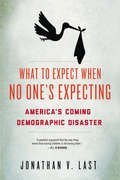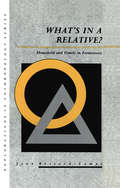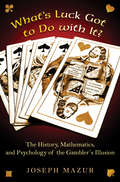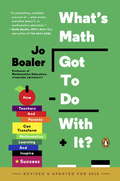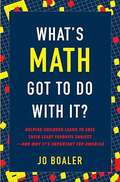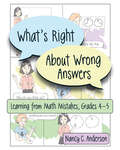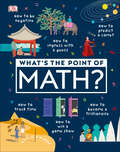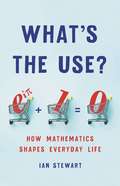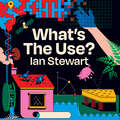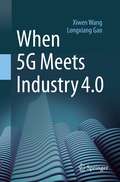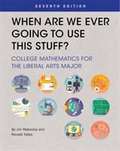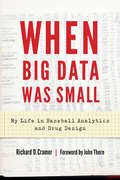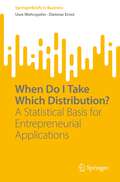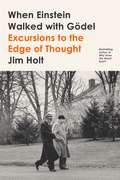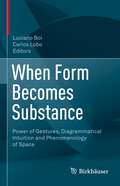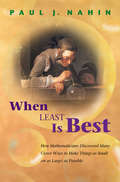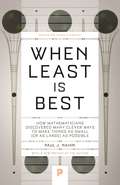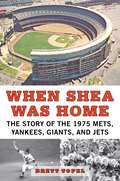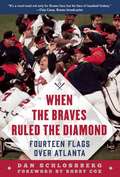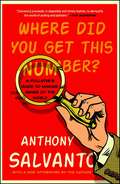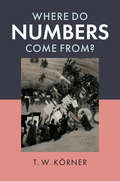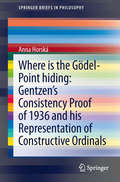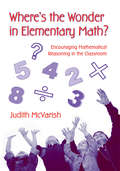- Table View
- List View
What to Expect When No One's Expecting
by Jonathan V. LastLook around you and think for a minute: Is America too crowded?For years, we have been warned about the looming danger of overpopulation: people jostling for space on a planet that's busting at the seams and running out of oil and food and land and everything else.It's all bunk. The "population bomb" never exploded. Instead, statistics from around the world make clear that since the 1970s, we've been facing exactly the opposite problem: people are having too few babies. Population growth has been slowing for two generations. The world's population will peak, and then begin shrinking, within the next fifty years. In some countries, it's already started. Japan, for instance, will be half its current size by the end of the century. In Italy, there are already more deaths than births every year. China's One-Child Policy has left that country without enough women to marry its men, not enough young people to support the country's elderly, and an impending population contraction that has the ruling class terrified.And all of this is coming to America, too. In fact, it's already here. Middle-class Americans have their own, informal one-child policy these days. And an alarming number of upscale professionals don't even go that far--they have dogs, not kids. In fact, if it weren't for the wave of immigration we experienced over the last thirty years, the United States would be on the verge of shrinking, too.What happened? Everything about modern life--from Bugaboo strollers to insane college tuition to government regulations--has pushed Americans in a single direction, making it harder to have children. And making the people who do still want to have children feel like second-class citizens.What to Expect When No One's Expecting explains why the population implosion happened and how it is remaking culture, the economy, and politics both at home and around the world.Because if America wants to continue to lead the world, we need to have more babies.
What's a Pair? What's a Dozen?
by Stephen R. SwinburneThe world is filled with numbers. From learning to count their fingers to learning to put on their shoes, children encounter mathematical concepts early in life. Steve Swinburne introduces children to number-related words in this bouncy, colorful photo-essay. From one to a dozen, lively photographs illustrated math words such as single, double, couple, and prefixes such as uni-, bi-, and tri-. The second half of the book is presented as a guessing game. Following Lots and Lots of Zebra Stripes and Guess Whose Shadow?, Steve Swinburne offers children another entertaining look at an all-important concept.
What's in a Relative: Household and Family in Formentera (Explorations In Anthropology Ser. #No. 5)
by Joan Bestard-CampsIn this ground-breaking study based on ethnographic research in Formentera, in the Balearic Islands, the author demonstrates that European kinship can become central to anthropological explanation once it is understood from a symbolic and cultural perspective. This book is an outstanding example of ethnographic analysis which is sensitive to the findings of demographic and historical research.
What’s Luck Got to Do with It?
by Joseph MazurWhy do so many gamblers risk it all when they know the odds of winning are against them? Why do they believe dice are "hot" in a winning streak? Why do we expect heads on a coin toss after several flips have turned up tails? What's Luck Got to Do with It? takes a lively and eye-opening look at the mathematics, history, and psychology of gambling to reveal the most widely held misconceptions about luck. It exposes the hazards of feeling lucky, and uses the mathematics of predictable outcomes to show when our chances of winning are actually good. Mathematician Joseph Mazur traces the history of gambling from the earliest known archaeological evidence of dice playing among Neolithic peoples to the first systematic mathematical studies of games of chance during the Renaissance, from government-administered lotteries to the glittering seductions of grand casinos, and on to the global economic crisis brought on by financiers' trillion-dollar bets. Using plenty of engaging anecdotes, Mazur explains the mathematics behind gambling--including the laws of probability, statistics, betting against expectations, and the law of large numbers--and describes the psychological and emotional factors that entice people to put their faith in winning that ever-elusive jackpot despite its mathematical improbability. As entertaining as it is informative, What's Luck Got to Do with It? demonstrates the pervasive nature of our belief in luck and the deceptive psychology of winning and losing.
What's Math Got to Do with It?
by Jo Boaler"Highly accessible and enjoyable for readers who love and loathe math." --BooklistA critical read for teachers and parents who want to improve children's mathematics learning, What's Math Got to Do with It? is "an inspiring resource" (Publishers Weekly). Featuring all the important advice and suggestions in the original edition of What's Math Got to Do with It?, this revised edition is now updated with new research on the brain and mathematics that is revolutionizing scientists' understanding of learning and potential.As always Jo Boaler presents research findings through practical ideas that can be used in classrooms and homes. The new What's Math Got to Do with It? prepares teachers and parents for the Common Core, shares Boaler's work on ways to teach mathematics for a "growth mindset," and includes a range of advice to inspire teachers and parents to give their students the best mathematical experience possible.
What's Math Got to Do with It?
by Jo Boaler"Highly accessible and enjoyable for readers who love and loathe math." --BooklistA critical read for teachers and parents who want to improve children's mathematics learning, What's Math Got to Do with It? is "an inspiring resource" (Publishers Weekly). Featuring all the important advice and suggestions in the original edition of What's Math Got to Do with It?, this revised edition is now updated with new research on the brain and mathematics that is revolutionizing scientists' understanding of learning and potential.As always Jo Boaler presents research findings through practical ideas that can be used in classrooms and homes. The new What's Math Got to Do with It? prepares teachers and parents for the Common Core, shares Boaler's work on ways to teach mathematics for a "growth mindset," and includes a range of advice to inspire teachers and parents to give their students the best mathematical experience possible.
What's Math Got to Do with It?
by Jo BoalerA recent assessment of mathematics performance around the world ranked the United States twenty-eighth out of forty countries in the study. When the level of spending was taken into account, we sank to the very bottom of the list. We are falling rapidly behind the rest of the developed world when it comes to math education-and the consequences are dire. In this straightforward and inspiring book, Jo Boaler, a professor of mathematics education at Stanford for nine years, outlines concrete solutions that can change things for the better, including classroom approaches, essential strategies for students, and advice for parents. This is a must-read for anyone who is interested in the mathematical and scientific future of our country. .
What's Right About Wrong Answers: Learning From Math Mistakes, Grades 4-5
by Nancy AndersonYou can&’t learn to hit a three-point shot without missing a lot of shots. You can&’t learn to play a piece of music correctly without striking a lot of wrong notes. And, as Nancy Anderson explains in What&’s Right About Wrong Answers: Learning From Math Mistakes, Grades 4-5 , You can&’t learn math without making mistakes. Anderson turns mistakes on their head and helps you cleverly use them to students&’ advantage. Each of the twenty-two activities in this book focuses on important ideas in grades 4 5 mathematics. By examining comic strips, letters to a fictitious math expert from confused students, and sample student work containing mistakes, your learners explore typical math mistakes, reflect on why they&’re wrong, and move toward deeper understanding. Each activity includes: A summary of the mathematical content and highlighted error Common Core connections Prerequisite knowledge that students need Big underlying math ideas Suggestions for implementing the activity Each activity can be used to enhance units of instruction and help students prepare for assessments that are aligned with the Common Core and similar state standards.
What's the Point of Math? (DK What's the Point of?)
by DKMath makes the world go around. An educational book that will give you surprising answers to everyday math challenges. This ebook unpacks how math is an essential part of our everyday life in ways that you never thought of. Full of crazy facts, magic tricks, and mathematical brainteasers and beautiful illustrations show you that math is interesting, fun, and not intimidating at all!Ever wondered where math originated from? This fantastic educational ebook unpacks all the curious questions that your child has about math including intriguing historical stories that explore the often-surprising origins of math that we use in our daily lives. Learn about how the formation of number sequences began, to the origins of trigonometry, and find out how to become a trillionaire! Math in our daily lives is used in many things that might not even seem that obvious. Math Controls Just About EverythingInspire your children with numbers and help bring mathematical explanations to life with this engaging educational book. Expand their knowledge in the complexity of understanding math by using simple illustrative examples. To make these topics more exciting and impactful, the ebook is full of great puzzles, awesome games, and interesting facts that will break barriers in their understanding. &“Try it out&” examples give mathematical explanations that are simple and easy to grasp. What&’s The Point Of Math? will not only change your child&’s perception of numbers but give them the skills and understanding to apply the principles in their everyday life!This educational ebook explains the point of:- Numbers and counting - Shapes and measuring- Patterns and sequences- Probability and logic- Data and statistics
What's the Use?: How Mathematics Shapes Everyday Life
by Ian StewartSee the world in a completely new way as an esteemed mathematician shows how math powers the world—from technology to health care and beyond. Almost all of us have sat in a math class, wondering when we'd ever need to know how to find the roots of a polynomial or graph imaginary numbers. And in one sense, we were right: if we needed to, we'd use a computer. But as Ian Stewart argues in What's the Use?, math isn't just about boring computations. Rather, it offers us new and profound insights into our world, allowing us to accomplish feats as significant as space exploration and organ donation. From the trigonometry that keeps a satellite in orbit to the prime numbers used by the world's most advanced security systems to the imaginary numbers that enable augmented reality, math isn't just relevant to our lives. It is the very fabric of our existence.
What's the Use?: The Unreasonable Effectiveness of Mathematics
by Ian StewartMany people think mathematics is useless. They're wrong. In the UK, the 2.8 million people employed in mathematical science occupations contributed £208 billion to the economy in a single year -- that's 10 per cent of the workforce contributing 16 per cent of the economy.What's the Use? asks why there is such a vast gulf between public perceptions of mathematics and reality. It shows how mathematics is vital, often in surprising ways, behind the scenes of daily life. How politicians pick their voters. How an absurd little puzzle solved 300 years ago leads to efficient methods for kidney transplants. How an Irish mathematician's obsession with a new number system improves special effects in movies and computer games. How SatNav relies on at least six mathematical techniques. And how a bizarre, infinitely wiggly curve, helps to optimise deliveries to your door.
When 5G Meets Industry 4.0
by Longxiang Gao Xiwen WangSince the 1980s, mobile communication has undergone major transitions from 1G to 4G, at a rate of roughly one generation per decade. And the next upgrade is set to come soon, with 5G heralding a new era of large-bandwidth Internet, and a multi-connection, low-latency Internet of Everything.5G technology will be the standard for next-generation mobile Internet, and it will not only enhance the individual user’s experience, but also provide technical support for artificial-intelligence-based applications, such as smart manufacturing, smart healthcare, smart government, smart cities and driverless cars. As a result, 5G is regarded as the “infrastructure” of the industrial Internet and artificial intelligence and both China and the United States are striving to become the 5G leader and spearhead this new generation of international mobile communication standards. Though trade tensions between China and the United States continue to escalate, with products ranging from soybeans to mobile phones and automobiles being affected, 5G technology may be the true cause of trade wars between the world’s top two economies.In short, 5G will change not only society, but also international trade patterns. This book describes various 5G scenarios, changes and values; explains the standards, technologies and development directions behind 5G; and explores new models, new formats and new trends in 5G-based artificial intelligence.
When Are We Ever Going to Use this Stuff?: College Mathematics for the Liberal Arts Major
by James Matovina Ronald YatesWhen Are We Ever Going to Use This Stuff? College Mathematics for the Liberal Arts Major is a college level mathematics textbook designed with liberal arts majors in mind. Standard mathematics texts typically mimic the style and tone of those written for STEM-track students. This text, while rigorous enough to ensure a high level of mastery over the material, uses practical, entertaining topics presented in a readable, student-centered style to teach mathematics concepts and skills for the non-major. When Are We Ever Going to Use This Stuff? emphasizes practical application over symbolic manipulation across several different topics that are ideal for the liberal arts major. Students learn where, when, why, and how the math will help them in their lives. The subject matter includes consumer math, apportionment, statistics, probability, set theory, geometry, right triangle trigonometry, and voting techniques, with the history of mathematics as a consistent motivational thread throughout. Concepts are taught within familiar contexts, with a focus on the development of problem-solving skills. When Are We Ever Going to Use This Stuff? is a fresh, student-friendly offering for lower-division courses that meet the math requirement for liberal arts students. Jim Matovina earned his M.S. in mathematics and a post-baccalaureate certificate in statistics at Purdue University Calumet. Professor Matovina teaches at the College of Southern Nevada, where he has also served as chair of the math department, as well as the department's webmaster. Ronald Yates earned his M.S. in mathematics at Montana State University and holds an M.Ed. in higher education leadership from the University of Nevada, Las Vegas. He is a professor of mathematics at the College of Southern Nevada, where he has served as the department's webmaster and parliamentarian.
When Big Data Was Small: My Life in Baseball Analytics and Drug Design
by Richard D. CramerRichard D. Cramer has been doing baseball analytics for just about as long as anyone alive, even before the term “sabermetrics” existed. He started analyzing baseball statistics as a hobby in the mid-1960s, not long after graduating from Harvard and MIT. He was a research scientist for SmithKline and in his spare time used his work computer to test his theories about baseball statistics. One of his earliest discoveries was that clutch hitting—then one of the most sacred pieces of received wisdom in the game—didn’t really exist. In When Big Data Was Small Cramer recounts his life and remarkable contributions to baseball knowledge. In 1971 Cramer learned about the Society for American Baseball Research (SABR) and began working with Pete Palmer, whose statistical work is credited with providing the foundation on which SABR is built. Cramer cofounded STATS Inc. and began working with the Houston Astros, Oakland A’s, Yankees, and White Sox, with the help of his new Apple II computer. Yet for Cramer baseball was always a side interest, even if a very intense one for most of the last forty years. His main occupation, which involved other “big data” activities, was that of a chemist who pioneered the use of specialized analytics, often known as computer-aided drug discovery, to help guide the development of pharmaceutical drugs. After a decade-long hiatus, Cramer returned to baseball analytics in 2004 and has done important work with Retrosheet since then. When Big Data Was Small is the story of the earliest days of baseball analytics and computer-aided drug discovery.
When Do I Take Which Distribution?: A Statistical Basis for Entrepreneurial Applications (SpringerBriefs in Business)
by Uwe Wehrspohn Dietmar ErnstThis book provides the statistical basis for quantitative risk management by presenting and explaining the most important distributions. Distributions describe the occurrence and impact of a risk. They are a prerequisite for risk aggregation, risk analysis and risk assessment as required by the German revision standards IDW PS 340, StaRUG and FISG.This book portrays the distributions that are fundamental for enterprise risk management and shows when and how they are used. These include the Bernoulli distribution, the binomial distribution, the Poisson distribution, the uniform distribution, the triangular distribution, the PERT distribution, the modified PERT distribution, the trapezoidal distribution, the custom distribution, the normal distribution, the lognormal distribution, the Weibull distribution, the expert distribution, the poly distribution and the compound distribution. Furthermore, the book explains how the parameterisation of the distributions can be done via expert estimates or algorithmic calibration.
When Einstein Walked with Gödel: Excursions to the Edge of Thought
by Jim HoltFrom Jim Holt, the New York Times bestselling author of Why Does the World Exist?, comes an entertaining and accessible guide to the most profound scientific and mathematical ideas of recent centuries in When Einstein Walked with Gödel: Excursions to the Edge of Thought.Does time exist? What is infinity? Why do mirrors reverse left and right but not up and down? In this scintillating collection, Holt explores the human mind, the cosmos, and the thinkers who’ve tried to encompass the latter with the former. With his trademark clarity and humor, Holt probes the mysteries of quantum mechanics, the quest for the foundations of mathematics, and the nature of logic and truth. Along the way, he offers intimate biographical sketches of celebrated and neglected thinkers, from the physicist Emmy Noether to the computing pioneer Alan Turing and the discoverer of fractals, Benoit Mandelbrot. Holt offers a painless and playful introduction to many of our most beautiful but least understood ideas, from Einsteinian relativity to string theory, and also invites us to consider why the greatest logician of the twentieth century believed the U.S. Constitution contained a terrible contradiction—and whether the universe truly has a future.
When Form Becomes Substance: Power of Gestures, Diagrammatical Intuition and Phenomenology of Space
by Luciano Boi Carlos LoboThis interdisciplinary volume collects contributions from experts in their respective fields with as common theme diagrams.Diagrams play a fundamental role in the mathematical visualization and philosophical analysis of forms in space. Some of the most interesting and profound recent developments in contemporary sciences, whether in topology, geometry, dynamic systems theory, quantum field theory or string theory, have been made possible by the introduction of new types of diagrams, which, in addition to their essential role in the discovery of new classes of spaces and phenomena, have contributed to enriching and clarifying the meaning of the operations, structures and properties that are at the heart of these spaces and phenomena.The volume gives a closer look at the scope and the nature of diagrams as constituents of mathematical and physical thought, their function in contemporary artistic work, and appraise, in particular, the actual importance of the diagrams of knots, of braids, of fields, of interaction, of strings in topology and geometry, in quantum physics and in cosmology, but also in theory of perception, in plastic arts and in philosophy. The editors carefully curated this volume to be an inspiration to students and researchers in philosophy, phenomenology, mathematics and the sciences, as well as artists, musicians and the general interested audience.
When Least Is Best
by Paul J. NahinWhat is the best way to photograph a speeding bullet? Why does light move through glass in the least amount of time possible? How can lost hikers find their way out of a forest? What will rainbows look like in the future? Why do soap bubbles have a shape that gives them the least area? By combining the mathematical history of extrema with contemporary examples, Paul J. Nahin answers these intriguing questions and more in this engaging and witty volume. He shows how life often works at the extremes--with values becoming as small (or as large) as possible--and how mathematicians over the centuries have struggled to calculate these problems of minima and maxima. From medieval writings to the development of modern calculus to the current field of optimization, Nahin tells the story of Dido's problem, Fermat and Descartes, Torricelli, Bishop Berkeley, Goldschmidt, and more. Along the way, he explores how to build the shortest bridge possible between two towns, how to shop for garbage bags, how to vary speed during a race, and how to make the perfect basketball shot. Written in a conversational tone and requiring only an early undergraduate level of mathematical knowledge, When Least Is Best is full of fascinating examples and ready-to-try-at-home experiments. This is the first book on optimization written for a wide audience, and math enthusiasts of all backgrounds will delight in its lively topics.
When Least Is Best: How Mathematicians Discovered Many Clever Ways to Make Things as Small (or as Large) as Possible (Princeton Science Library #118)
by Paul J. NahinA mathematical journey through the most fascinating problems of extremes and how to solve themWhat is the best way to photograph a speeding bullet? How can lost hikers find their way out of a forest? Why does light move through glass in the least amount of time possible? When Least Is Best combines the mathematical history of extrema with contemporary examples to answer these intriguing questions and more. Paul Nahin shows how life often works at the extremes—with values becoming as small (or as large) as possible—and he considers how mathematicians over the centuries, including Descartes, Fermat, and Kepler, have grappled with these problems of minima and maxima. Throughout, Nahin examines entertaining conundrums, such as how to build the shortest bridge possible between two towns, how to vary speed during a race, and how to make the perfect basketball shot. Moving from medieval writings and modern calculus to the field of optimization, the engaging and witty explorations of When Least Is Best will delight math enthusiasts everywhere.
When Shea Was Home: The Story of the 1975 Mets, Yankees, Giants, and Jets
by Brett TopelFour teams, 175 games, 3,738,546 fans--one stadium. If 1975 wasn’t the most successful year in New York sports--and it wasn’t--then it was certainly one of the oddest. For that one crazy season, all four New York teams--the Mets, Jets, Yankees, and Giants--called Shea Stadium home. When Shea was Home includes interviews with the stadium’s former head groundskeeper, the legendary Pete Flynn, as well as Jerry Koosman, Bud Harrelson and Ed Kranepool of the Mets, Giants owner John Mara, Rich Caster of the Jets, former Super Bowl MVP quarterback Doug Williams, who played that year at Shea for Grambling, and many more! This well-written narrative includes information about the stadium, the teams, the players, how the teams coexisted, and how they didn't. When Shea was Home takes New York sports fans on a unique trip down memory lane, offering context on the national and local history and culture of the time. It is perfect for the avid New York sports aficionado--regardless of team allegiance!
When the Braves Ruled the Diamond: Fourteen Flags over Atlanta
by Dan SchlossbergFrom 1991 through 2005, the Atlanta Braves did something no pro sports team can match, finishing in first place for fourteen consecutive seasons. <P><P>During that stretch, the Braves paired powerful pitching with potent hitting that produced under pressure. Hall of Fame manager Bobby Cox won with veteran teams, young teams, slugging teams, and several times with teams that emphasized speed and defense. His teams captured on hundred wins in six different seasons. <P><P>In When the Braves Ruled the Diamond, now newly updated to include a discussion of the team's latest Hall of Fame inductees, former AP sportswriter Dan Schlossberg covers the record-breaking era that transformed Atlanta from the Bad-News Braves to America's Team. <P><P>With separate chapters on Cox, fabled pitching coach Leo Mazzone, and Hall of Fame pitchers Greg Maddux, Tom Glavine, and John Smoltz, this book also highlights the contributions of Andres Galarraga, Andruw Jones, Chipper Jones, Brian Jordan, Javy Lopez, Terry Pendleton, and many more Braves stars. <P><P>It features year-by-year summaries, Opening Day lineups, and even oddball anecdotes that explain why the fourteen-year streak may never be duplicated. It is the perfect gift for fans of baseball history as well as fans of the Atlanta Braves!
Where Did You Get This Number?: A Pollster's Guide to Making Sense of the World
by Anthony SalvantoCBS News’ Elections and Surveys Director Anthony Salvanto takes you behind the scenes of polling to show you how to think about who we are and where we’re headed as a nation.As Elections and Surveys Director for CBS News, it’s Anthony Salvanto’s job to understand you—what you think and how you vote. He’s the person behind so many of the poll numbers you see today, making the winner calls on election nights and surveying thousands of Americans. In Where Did You Get This Number? A Pollster’s Guide to Making Sense of the World, Salvanto takes readers on a fast-paced, eye-opening tour through the world of polling and elections and what they really show about America today, beyond the who's-up-who’s-down headlines and horse races. Salvanto is just the person to bring much-needed clarity in a time when divisions seem to run so deep. The language of polling may be numbers, but the stories it tells are about people. In this engaging insider’s account, Salvanto demystifies jargon with plain language and answers readers’ biggest questions about polling and pollsters. How can they talk to 1,000 people and know the country? How do they know the winner so fast? How do they decide what questions to ask? Why didn't they call you? Salvanto offers data-driven perspective on how Americans see the biggest issues of our time, from the surprising 2016 election, to the shocks of the financial crisis, the response to terrorism and the backlash against big money. He doesn’t shy away from pointing out what’s worked and what hasn’t. Salvanto takes readers inside the CBS newsroom on Election Night 2016 and makes readers rethink conventional wisdom and punditry just in time for the 2018 midterms. He shows who really decides elections and why you should think about a poll differently from the forecasts popularized by Nate Silver and others. Where Did You Get This Number? is an essential resource for anyone interested in politics—and how to better measure and understand patterns of human behavior. For any American who wants to get a better read on what America is thinking, this book shows you how to make sense of it all.
Where Do Numbers Come From?
by T. W. KörnerWhy do we need the real numbers? How should we construct them? These questions arose in the nineteenth century, along with the ideas and techniques needed to address them. Nowadays it is commonplace for apprentice mathematicians to hear 'we shall assume the standard properties of the real numbers' as part of their training. But exactly what are those properties? And why can we assume them? This book is clearly and entertainingly written for those students, with historical asides and exercises to foster understanding. Starting with the natural (counting) numbers and then looking at the rational numbers (fractions) and negative numbers, the author builds to a careful construction of the real numbers followed by the complex numbers, leaving the reader fully equipped with all the number systems required by modern mathematical analysis. Additional chapters on polynomials and quarternions provide further context for any reader wanting to delve deeper.
Where is the Gödel-point hiding: Gentzen's Consistency Proof of 1936 and His Representation of Constructive Ordinals
by Anna HorskáThis book explains the first published consistency proof of PA. It contains the original Gentzen's proof, but it uses modern terminology and examples to illustrate the essential notions. The author comments on Gentzen's steps which are supplemented with exact calculations and parts of formal derivations. A notable aspect of the proof is the representation of ordinal numbers that was developed by Gentzen. This representation is analysed and connection to set-theoretical representation is found, namely an algorithm for translating Gentzen's notation into Cantor normal form. The topic should interest researchers and students who work on proof theory, history of proof theory or Hilbert's program and who do not mind reading mathematical texts.
Where's the Wonder in Elementary Math?: Encouraging Mathematical Reasoning in the Classroom
by Judith McVarishThis book argues that even in today's high-stakes testing environment, 'teaching to the test' need not be teachers’ only focus as they introduce young children to mathematics. Judith McVarish demonstrates how building a community of learners and using problem solving to engage students can help teachers encourage students’ disposition to creative thinking and reasoning—skills that can otherwise become lost due to the pressure of the many other expectations placed upon both teachers and students. This book offers strategies for infusing mathematics learning and reasoning into elementary school classrooms while meeting curriculum and testing mandates. The teacher researcher component of each chapter provides a vehicle for teachers to bring their own expertise and questions back into the teaching and learning equation.
